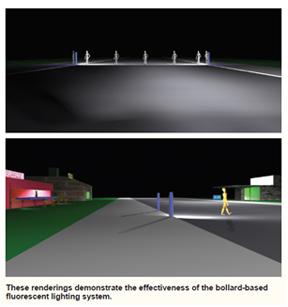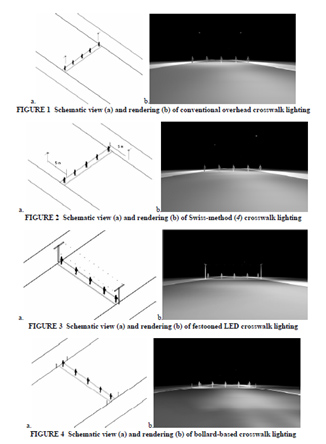 Bollard Luminaires Create Pedestrian Crosswalk Safety in an Economic Model
Bollard Luminaires Create Pedestrian Crosswalk Safety in an Economic Model
According to the Federal Highway Administration, more than a thousand pedestrians were killed in the U.S. while crossing roads or at intersections in 2006, accounting for more than 20% of the total number of pedestrians killed in traffic accidents. Furthermore, nighttime fatal accident rates in unlighted areas are approximately three times higher than daytime rates, suggesting that visibility is a crucial risk factor.
This data shows that intersection improvements need to be made, and scientists at Rensselaer Polytechnic Institute’s Lighting Research Center (LRC) are helping to evaluate different crosswalk lighting systems in order to improve pedestrian safety.
 In conventional intersections, lighting is typically provided by pole-mounted luminaires. These systems illuminate the crosswalk as well as surrounding areas, and do not always provide enough contrast between the pedestrian and his or her background. The LRC sought to find a lighting solution that illuminates the pedestrian but not the background in order to increase contrast and improve pedestrian visibility and detection.
In conventional intersections, lighting is typically provided by pole-mounted luminaires. These systems illuminate the crosswalk as well as surrounding areas, and do not always provide enough contrast between the pedestrian and his or her background. The LRC sought to find a lighting solution that illuminates the pedestrian but not the background in order to increase contrast and improve pedestrian visibility and detection.
In a recent study by the LRC’s Transportation group, under the direction of Dr. John Bullough, scientists identified and tested a novel bollard-based approach as an economical and viable way to increase crosswalk safety and visibility. The bollard approach, which utilizes short vertical posts containing linear light sources inside, addressed the need to contrast pedestrians from their surroundings in a way that traditional pole-mounted luminaries did not achieve. Additionally, based upon economic analyses, the bollard-based system was less expensive to install, maintain and operate than the typical crosswalk lighting system. These evaluations were supported by a full-scale mock-up field demonstration conducted in New Jersey, where professionals from transportation, transit and public safety organizations observed the prototype bollard-based lighting system.
A temporary, prototype fluorescent bollard system was installed at a crosswalk along U.S. Route 9 in Middlesex County, New Jersey. Individuals from New Jersey Department of Transportation (NJDOT), New Jersey Transit, and the Old Bridge Police Department evaluated the prototype alongside conventional lighting. “Overall, the bollards were judged as being likely to increase pedestrian safety,” said Bullough, principal investigator for the project. “At the end of the study, the group made recommendations for improvements, such as reducing glare by installing louvers and dimming when no pedestrians were present.” The group also suggested adding flashing LEDs on the bollard, which would be activated with push-button controls or motion sensors, for additional safety.
This study was supported by the NJDOT and the Federal Highway Administration through the University Transportation Research Center at the City University of New York. The bollards were developed from floodlights donated by Philips Hadco. Results were recently presented in Washington D.C. at the Transportation Research Board Annual Meeting.
Publications
- Bullough, J. D., X. Zhang,+ N. P. Skinner and M. S. Rea. 2009. Design and Evaluation of Effective Crosswalk Illumination,
 FHWA-NJ-2009-03 [report to the New Jersey Department of Transportation]. Trenton, NJ: New Jersey Department of Transportation. (FULL TEXT)
FHWA-NJ-2009-03 [report to the New Jersey Department of Transportation]. Trenton, NJ: New Jersey Department of Transportation. (FULL TEXT) - Project Sheet

- Press Release
Sponsors
NJDOT and the Federal Highway Administration via subcontract through the University Transportation Research Center at the City University of New York. Equipment was provided by LRC partner Philips Hadco.


